Understanding GIA Fluorescence in Gemstones
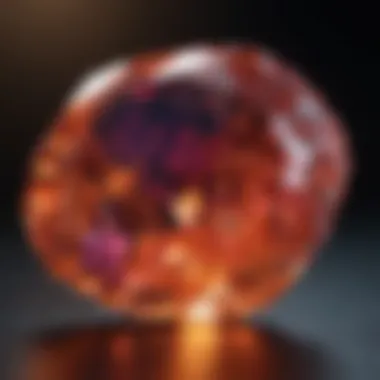
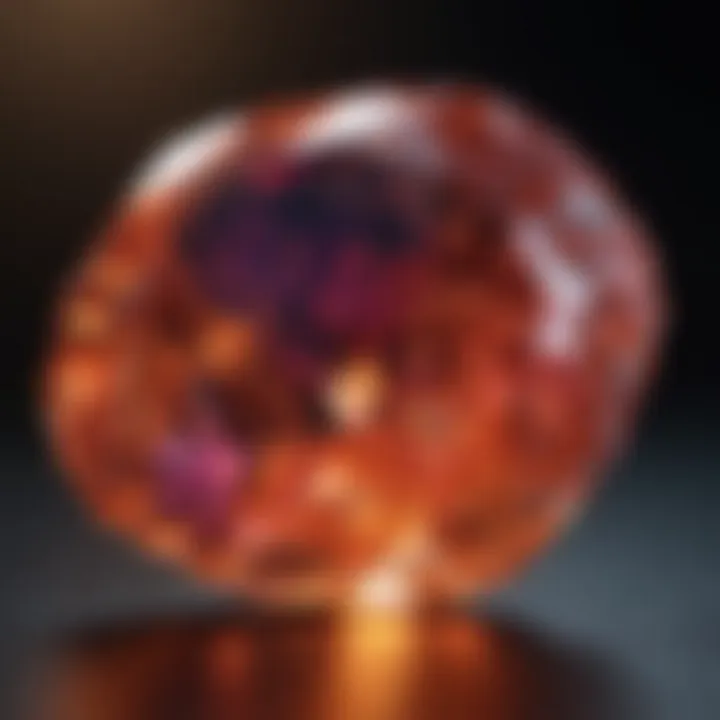
Intro
Fluorescence in gemstones is a phenomenon that has intrigued jewelers, collectors, and scientists alike. At its core, fluorescence is the ability of a material to absorb light at one wavelength and re-emit it at another, often creating a vivid display of color that can dramatically enhance a gemstone's appearance. This captivating trait is not merely a spectacle; it plays a critical role in gem valuation, identification, and the broader market dynamics. In this exploration, we will unravel the layers of this concept, particularly focusing on how it is assessed by the Gemological Institute of America (GIA).
The GIA’s analysis of fluorescence goes beyond simple observation. It dives into the science and significance of how this quality affects a gemstone's desirability and value. Furthermore, the multifaceted nature of fluorescence—its types, the elements contributing to it, and the aesthetic implications—forms a foundational understanding that every gemstone enthusiast should grasp. Let's embark on this illuminating journey to reveal the significance of GIA fluorescence in the world of gemstones.
Gemstone Overview
Definition and Origins
Gemstones are typically defined as precious or semi-precious stones that are prized for their beauty, rarity, and durability. These natural minerals have been admired by humans for thousands of years, often used in jewelry or as decorative items. The origins of these stones are as varied as their types, often formed deep within the Earth under immense pressure and temperature—conditions that lead to the creation of dazzling crystals. Gems like diamonds, rubies, and emeralds each carry their own unique stories and histories.
Historical Significance
Historically, gemstones have held significant cultural and economic value. From ancient civilizations adorning their rulers to modern jewelers crafting pieces that fetch millions, the significance of gems has evolved but remains deeply rooted in human history. Consider the ancient Egyptians, who believed that lapis lazuli had mystical powers or that diamonds were the tears of the gods. Today, in a more scientifically driven age, the GIA's role in assessing these gemstones sheds light on the intrinsic value established through rigorous examination, including the evaluation of fluorescence.
Gemstone Properties
Hardness and Durability
The hardness and durability of gemstones are crucial attributes that determine their suitability for various applications, particularly in jewelry. The Mohs scale of hardness ranges from 1 (talc) to 10 (diamond), with many popular gemstones sitting between 5 and 9. This measure not only indicates how resistant a stone is to scratching but also impacts how it can be worn and maintained over the years. Choosing the right gem involves weighing this factor along with other properties to ensure longevity.
Color and Clarity
Color and clarity are perhaps two of the most noticed and valued properties in gemstones. Color, influenced by the presence of different trace elements, gives gemstones their beauty and appeal. Clarity, measured by the presence of inclusions or blemishes, also plays a pivotal role in valuation. Fluorescence can enhance these properties substantially, sometimes making a mediocre stone appear extraordinary under certain light conditions.
"The magic of fluorescence can take an everyday gem and transform its presence, inviting both admiration and curiosity."
Understanding how GIA evaluates fluorescence opens the door to a nuanced appreciation of what makes a gemstone truly special.
Preface to GIA Fluorescence
The world of gemstones is full of wonders, and one of the most fascinating attributes that a gemstone can possess is fluorescence. This natural phenomenon, when correctly understood, adds layers of beauty and value to such stones. In the context of this article, we aim to delve into the concept of GIA fluorescence and how it impacts gemstones, their evaluation, and their market appeal.
Understanding GIA fluorescence is not just a matter of scientific curiosity; it has immense implications for collectors and enthusiasts alike. It allows buyers and sellers to make informed decisions while also enhancing the aesthetic appreciation of these gems. In this section, we will lay the groundwork by discussing the crucial aspects of fluorescence, the GIA's role in assessing it, and the historical significance of these practices.
Definition of Fluorescence
Fluorescence, at its core, refers to the process through which certain materials absorb light and then emit it almost immediately. In gemstones, this can manifest in various vivid colors depending on the specific traits of the stone and the light source involved. When a gemstone is exposed to ultraviolet (UV) light, the minerals within can absorb that energy and re-emit it within a short time frame, usually within microseconds. This characteristic can result in dramatic visual effects that vary by gemstone type, creating a unique interplay of color and glow.
Overview of the GIA
The Gemological Institute of America (GIA) has been a cornerstone of gemological education and research since its establishment in 1931. With its commitment to maintaining high standards for grading and evaluating gemstones, the GIA equips gemologists, buyers, and collectors with vital knowledge about the quality and provenance of the gems they encounter. GIA fluorescence grading became a critical aspect of their assessment processes, offering an objective method for understanding variations in fluorescence and its implications for gemstone value.
Historical Context
Tracing the history of fluorescence in gemstones leads us back to the discoveries made in the early 20th century when gemologists began systematically categorizing different reactions of minerals under UV light. In the years that followed, institutions like the GIA laid the groundwork for significant advancements in gemological science. As the industry evolved, the significance of GIA fluorescence assessments became increasingly evident, shaping market perceptions and contributing to a greater understanding of gemstones’ identities.
In sum, mastering the nuances around GIA fluorescence is essential for anyone involved in the gemstone trade or even for casual enthusiasts. By illuminating the topics of fluorescence, the GIA’s crucial role, and the history behind this practice, we set the stage for deeper exploration into the implications and practical aspects of fluorescence in gemstones.
The Science Behind Fluorescence
Fluorescence is not just a curious quirk of certain gemstones; it holds profound implications for both their aesthetic appeal and market value. Understanding the science behind fluorescence allows gemstone enthusiasts and collectors to make informed decisions. This section will delve into the mechanisms that underpin this fascinating phenomenon, illustrating how it varies among different gemstones and how those variations can influence their desirability.
Mechanism of Fluorescence
Fluorescence occurs when a gemstone absorbs light energy and then re-emits it. It’s an intriguing process influenced by two main factors: energy absorption and emission, and the chemical composition of the stone. Let’s take a closer look at these aspects.
Energy absorption and emission
The process starts when a gemstone is exposed to radiation, typically ultraviolet light. The gemstone absorbs this energy, which excites its electrons to a higher energy level. When these electrons return to their original state, they release the absorbed energy in the form of visible light. This transformation is what gives gemstones their colorful glow under UV light.
This has a key characteristic: the quality of the emitted light can vary significantly. Gems that exhibit strong fluorescence might appear different when one compares them under natural daylight and UV light. This distinct property makes fluorescence a captivating subject to study. It serves a practical purpose too. For instance, it can help with gemstone identification, allowing gemologists to differentiate between natural stones and synthetics, as many synthetics do not fluoresce as their natural counterparts do.
Thus, the unique feature of energy absorption and emission provides a robust advantage for the appraisal of gemstones. However, not all types exhibit strong fluorescence. In some cases, the effect can be muted, which may limit its application in certain evaluations.
Chemical composition effects


The chemical makeup of a gemstone plays a crucial role in its fluorescence. Different elements and minerals absorb and emit light differently, impacting the fluorescence seen in various stones. For example, the presence of trace elements such as boron in diamonds can lead to blue fluorescence, whereas other compositions might not exhibit any effect at all.
This characteristic is particularly beneficial for the field as it provides vital clues in classification and grading. When gemologists assess a stone's fluorescence properties, they can glean valuable insights into its origin and authenticity. Moreover, chemical composition influences the intensity and color of the fluorescence, which can enhance or obscure the overall beauty of a stone.
The unique feature of this process is that even slight variations in mineral makeup can lead to drastically different fluorescence outcomes, offering a spectrum of possibilities for gem identification and evaluation. However, complexities arise since not all stones respond predictably. In some cases, internal defects or other factors can obscure the fluorescence, making identification more challenging.
Types of Fluorescence
Fluorescence can be categorized depending on the wavelength of light that excites the gemstones. Two primary terms come into play: shortwave and longwave UV fluorescence. Both types hold significant importance, as they can influence how gemstones are perceived in various settings.
Shortwave UV fluorescence
Shortwave UV fluorescence is predominantly seen when a gemstone is exposed to shortwave UV light, typically around 254 nanometers. One key characteristic of this type is its potential to produce a stark, vivid response in some stones, making them appear highly luminescent.
This feature can be a big hit among collectors and enthusiasts who appreciate dramatic visual effects. However, not every stone responds well to shortwave UV light; some gems may remain completely inert under such exposure. Still, for those that do fluoresce, they often exhibit bright colors that can enhance their inherent beauty.
The advantage of understanding shortwave fluorescence lies in its potential for differentiation. It opens the door for gemologists to identify stones that may otherwise be confusing under normal lighting conditions.
Longwave UV fluorescence
On the other hand, longwave UV fluorescence operates under different principles. This type is triggered by longer wavelengths, usually around 365 nanometers. The reaction is often subtler than that produced by shortwave UV, leading to more muted, soft glows in some gemstones.
This characteristic may appear less flashy, but it has its own charm. It can add a layer of mystery to a stone, as the glow can be almost undetectable in normal lighting but comes alive under UV light. That can make for a delightful experience when revealing a gem's secret qualities.
One of the limitations of longwave fluorescence is that some stones may only exhibit weak fluorescence, making them challenging to assess accurately. Yet, for intricately crafted pieces, this can be an appealing attribute, emphasizing subtlety over boldness.
Both types and their implications
Both shortwave and longwave fluorescence offer invaluable insights into gemstone evaluation. Understanding how each type impacts the appearance of stones can crucially guide market values and preferences among consumers.
The interplay of both types can also create captivating effects when viewed under different lighting conditions. Some collectors seek gems that demonstrate both responses, as these can provide a more dynamic visual experience.
However, one must also recognize that variations in fluorescence can significantly impact the perceived value of gemstones. Buyers may gravitate towards stones with strong fluorescence in a competitive market, while those with weaker fluorescence may suffer in attractiveness and price.
GIA's Approach to Measuring Fluorescence
The Gemological Institute of America (GIA) plays a pivotal role in the evaluation of gemstones. One of the important aspects of their analysis is fluorescence. This phenomenon can significantly influence both the perceived value and aesthetic appeal of a gem. By using a systematic approach to measuring fluorescence, GIA provides a consistent and well-recognized framework for assessing and comparing gemstones. Such a thorough approach helps jewelers, collectors, and enthusiasts make informed decisions.
Fluorescence Grading System
GIA employs a comprehensive grading system tailored to evaluate fluorescence in gemstones. This system categorizes fluorescence levels, offering transparency regarding a stone's characteristics.
Scale and Criteria
The grading scale used by GIA is relatively straightforward, utilizing specific criteria to ensure a uniform evaluation. This gives both buyers and sellers a reference point when appraising stones. Many gemstones are marked on a scale ranging from none to strong, which determines their fluorescence level under ultraviolet light. Building this system allows for easy classification and communication about gemstone quality.
One key characteristic of the scale is its ability to adjust based on the type of gemstone considered. For example, diamonds and colored stones may exhibit significantly different fluorescence traits. This adaptability serves as a beneficial choice within this context. The primary benefit of this grading scale is clarity. Potential buyers and sellers can confidently understand a stone's fluorescent behavior and thereby consider its market implications.
However, it should be noted that while the grading system offers clarity, it may lack detail when it comes to understanding the specific types of fluorescence exhibited by certain gemstones. Some might argue that a more nuanced approach could enhance buyer education, but the existing system remains one of the most well-known grading methodologies.
Visual Presentation of Grades
Visual presentation is an integral part of GIA's grading process, as it provides a clear representation of fluorescence levels. The GIA uses diagrams and grading reports, which include information presented in an easily digestible format, often featuring color-coded sections to indicate varying degrees of fluorescence. This visual clarity aids users in grasping the nuances of a particular stone's behavior under ultraviolet light.
The ease of interpretation is a vital characteristic that makes this presentation approach popular. When someone picks up a report or views an online listing, they can quickly assess a gem’s qualities without getting lost in technical jargon. This visual element also fosters a better understanding of how fluorescence contributes to the overall value of gemstones.
On the flip side, this system might sometimes oversimplify the significance of fluorescence, potentially leading buyers to overlook more complex nuances that affect a stone's character. Still, the visual presentation undeniably offers an accessible means for gemstone enthusiasts to orient themselves within the often intricate gemstone market.
Instruments Used for Assessment
In gauging fluorescence, GIA utilizes several sophisticated instruments. These tools ensure accurate and reliable assessments, retaining a high standard within the gemstone evaluation process.
UV Lamps
UV lamps are crucial tools in the fluorescence assessment process. Designed to emit ultraviolet light, these lamps enable gemologists to observe how gemstones react when exposed to specific wavelengths. This immediate insight shows the gemstone's characteristics that may not be visible under standard lighting.
A distinct advantage of using UV lamps is their straightforward functionality. They are relatively easy to use and can produce consistent results across different evaluations. Furthermore, they are widely available in both professional and amateur settings, making them a popular choice among gemologists.
However, it’s important to note that UV lamps can sometimes produce misleading readings. Some gemstones may react differently based on surrounding materials. Careful observation must accompany usage to ensure reliable results.
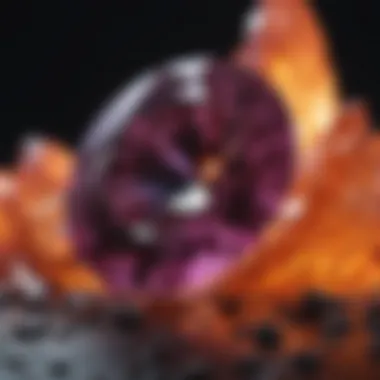
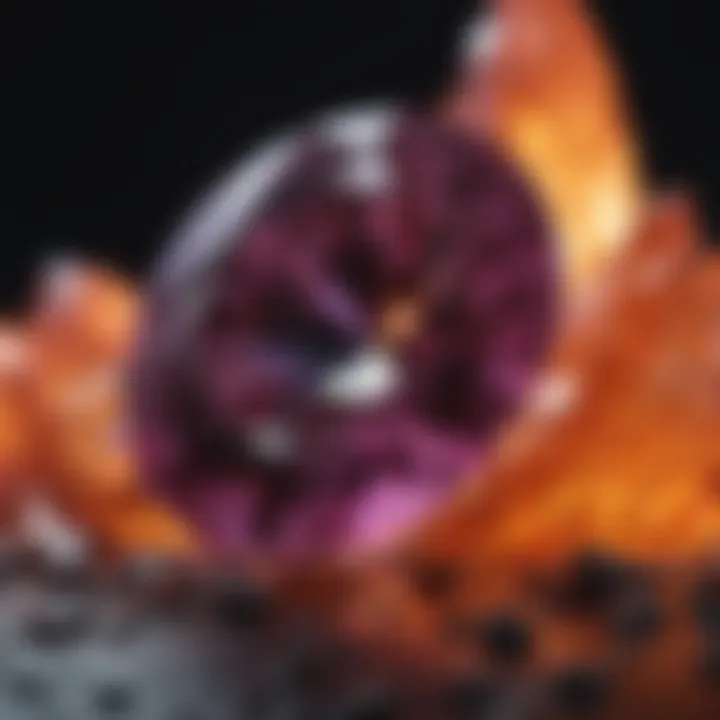
Spectrophotometers
Another significant tool in GIA's toolkit is the spectrophotometer. This instrument provides a detailed spectrum of the light emitted by a gemstone when it is subjected to ultraviolet light. Essentially, it offers a scientific measurement of the stone’s fluorescence, making it possible to analyze the intensity and quality of the glow.
The key characteristic of spectrophotometers is their precision. They provide a wealth of data, which allows gemologists to create comprehensive profiles of gemstones. This is particularly beneficial when comparing similar stones with slight variations.
Yet, spectrophotometers require specialized training to operate effectively. This may limit their accessibility for some gemstone enthusiasts. Their sophisticated nature can act as a double-edged sword; while they produce precise data, they may alienate users who are less experienced with advanced instruments.
Understanding GIA’s methods for measuring fluorescence offers valuable insights into how gemstones are evaluated. By exploring their grading system and assessment instruments, one can appreciate the science that underpins gemstone valuation and the nuances that might not be immediately evident to all gemstone enthusiasts.
Implications of GIA Fluorescence on Gemstones
Understanding GIA fluorescence offers a wealth of insight into gemstone evaluation and appreciation. The implications of this phenomenon extend beyond mere aesthetic appeal to more practical considerations, directly influencing market value and buyer perceptions. This section unpacks the nuances involved in assessing how fluorescence can affect both the monetary worth and the visual enchantment of gemstones.
Fluorescence and Value
Influence on market price
When discussing the influence of fluorescence on market price, one must consider how this characteristic can serve as a double-edged sword. In some markets, certain fluorescent qualities can drive prices higher due to rarity or unique attributes. For instance, diamonds with strong blue fluorescence often fetch a premium. This is because under ultraviolet light or certain artificial lighting, they can appear more vibrant, thus capturing buyers’ attention.
On the flip side, some buyers are wary of fluorescence. Strong fluorescence in some colored stones may lead to a decrease in value. This is typically seen in stones like rubies, where fluorescence can bleach out the color, making them look less desirable under different lighting. Hence, the influence of market pricing fluctuates greatly depending on buyer sentiment, where certain characteristics may appear as truly valuable to some and disadvantageous to others.
Buyer perceptions
Buyer perceptions also play a pivotal role in how fluorescence influences the market. To many consumers, fluorescence is associated with lively brilliance and enhanced gem qualities.
High-quality gems that exhibit fluorescence can evoke intrigue and a sense of exclusivity. In contrast, some buyers feel that fluorescence can detract from the gemstone’s natural beauty. For example, while some collectors adore bright, vividly fluorescent stones, others may prefer stones that glow softly or don't fluoresce at all.
Thus, familiarity with fluorescence profoundly affects how buyers engage with gems. Knowledgeable buyers are likely to appreciate the lively dance of colors, while those lacking such insight might steer clear of stones perceived as less natural due to strong fluorescence.
Impact on Aesthetics
Visual appeal in various light conditions
The visual appeal of gemstones in different lighting conditions is crucial for both wearers and sellers. Under ultraviolet light, many fluorescent stones exhibit a captivating glow, enhancing their charm significantly. The phenomenon can create a kaleidoscopic impression that captures attention beautifully, especially at social gatherings or under club lights.
However, this unique effect is context-dependent. In daylight, a fluorescent gemstone can often appear differently, sometimes losing its luster. Hence, buyers might need to consider not just the stone's beauty in isolation but how it performs across various situations and environments. The ability or inability to adapt under varying lights can drastically shape a gemstone's aesthetic attraction.
Contrast with non-fluorescent stones
Examining the contrast between fluorescent and non-fluorescent stones reveals a broader narrative about natural versus enhanced beauty. Non-fluorescent stones tend to convey a classic elegance, often sought after by collectors who value authenticity.
In contrast, fluorescent stones hint at a more playful side of gemology, adding layers of complexity to gemstones like sapphires and diamonds. This playful quality can be a significant advantage, attracting an audience that cherishes vibrancy and excitement.
However, the distinction comes with its challenges. A buyer who favors traditional aesthetics may perceive fluorescent stones as gaudy or overly ostentatious. The decision ultimately rests on personal taste and what value they place on the vibrant allure versus the classic, steady charm of non-fluorescent gemstones.
The role of GIA fluorescence is not just about numbers and grades; it shapes entire conversations about value and significance in the realm of gemstone appreciation.
Factors Influencing GIA Fluorescence
Understanding the factors that influence GIA fluorescence is crucial for a comprehensive grasp of how gemstones behave under ultraviolet light. Various elements come into play, each having unique attributes that contribute to the way fluorescence manifests itself in stones. This section delves into how specific gemstone types and environmental conditions affect fluorescence.
Gemstone Type
Diamond
When it comes to diamonds, their fluorescence can be quite the mixed bag. While some exhibit a strong blue glow under UV light, others may show little to no reaction. The key characteristic of diamonds that makes them particularly interesting in the world of fluorescence is their chemical purity and crystal structure. Diamonds that are higher in quality and clarity are less likely to show fluorescence, while those with inclusions might exhibit more noticeable reactions.
A unique feature of diamonds is that their fluorescence can impact their perceived value. Some buyers shy away from diamonds with strong fluorescence due to concerns over "milky" appearances, while others see it as a uniqueness, possibly enhancing their attraction. Thus, in the context of this discussion, diamonds provide insight into how fluorescence can affect market perceptions and value.
Colored gemstones
Colored gemstones, on the other hand, present a different story altogether. Stones like rubies, sapphires, and emeralds can display vivid fluorescence, emanating different colors altogether depending on their compositional elements. The key characteristic here is the presence of trace elements such as chromium and titanium, which can lead to a brighter and more vibrant appearance under UV light.
What's fascinating about colored gemstones is that their fluorescence can augment their overall appeal. In some cases, it can positively influence market value due to the aesthetic qualities it provides. However, certain buyers may be wary of synthetic stones that mimic natural fluorescence, which can complicate their identification. Hence, understanding how colored gemstones react to UV light is essential for enthusiasts and collectors alike.
Environmental Conditions
Environmental conditions also play a significant role in the fluorescence of gemstones. Understanding these factors is fundamental to accurately evaluating the effects of fluorescence.
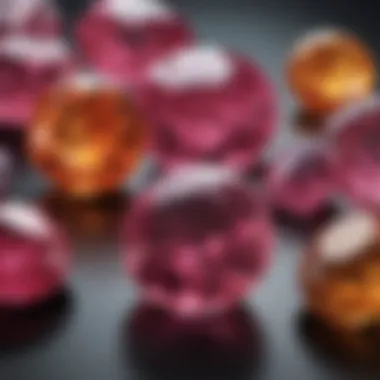
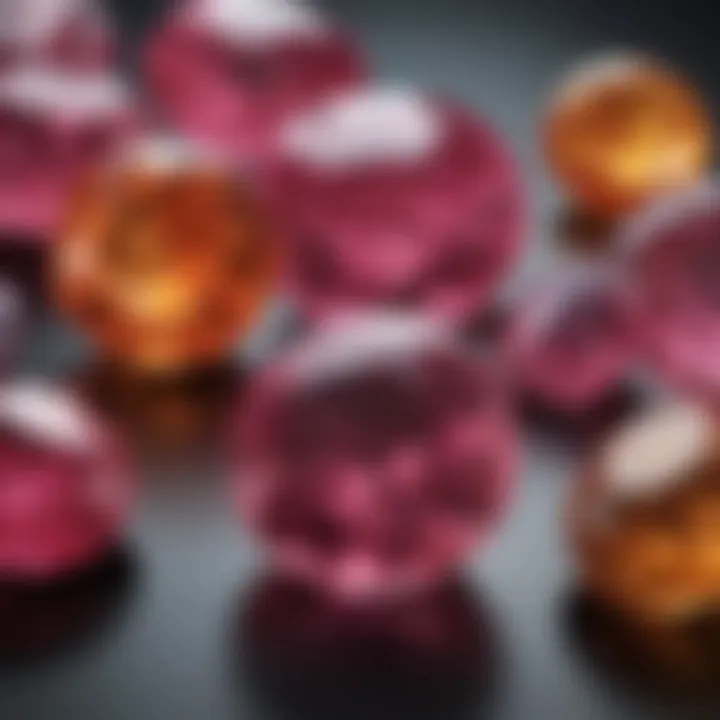
Temperature effects
Temperature can greatly impact fluorescence. At increased temperatures, fluorescence may decrease or alter, while cooler environments often enhance the glowing effect. This phenomenon largely occurs due to changes in the energy levels of the gemstone’s atoms, which can either absorb or emit light differently under varying temperatures. This aspect becomes particularly relevant when assessing gemstones in different settings and conditions.
A unique feature here is how temperature can not just diminish or amplify fluorescence but can result in unique lighting effects when combined with other environmental factors. However, one needs to be cautious because someone might mistake a dimmer fluorescence for a lower quality stone, when in fact it could be just temperature-induced change.
Lighting conditions
Last but certainly not least, lighting conditions are a crucial element that influences GIA fluorescence. The kind of UV light used for testing can shift results significantly, with varying wavelengths affecting how gems fluoresce. Shortwave UV light often elicits different responses than longwave light, and some stones might even react better in one versus the other.
Understanding these lighting conditions helps put gemstones in their best light—figuratively and literally. However, discerning enthusiasts must be wary of comparing stones under variable lighting, as results may not be directly comparable.
The interplay of factors like gemstone type and environmental conditions brings a greater complexity to the study of fluorescence in gemstones, revealing both aesthetic beauty and market implications.
In a nutshell, the factors influencing GIA fluorescence not only enrich the scientific study but also have real-world implications for valuation and identification. These nuances invite gem enthusiasts into a deeper exploration of the fascinating world of fluorescence.
Fluorescence in Gemstone Identification
Fluorescence plays a pivotal role in gemstone identification, offering gemologists and enthusiasts alike a reliable tool for distinguishing between various types of stones. This unique property, where gems absorb light and re-emit it at a different wavelength, can reveal crucial insights about a stone's composition, origin, and authenticity. In a marketplace filled with synthetics and imitations, understanding the significance of fluorescence becomes essential for any serious collector or jewelry designer.
Role in Differentiation
Distinguishing similar stones
The process of distinguishing similar stones using fluorescence hinges on the presence of specific spectral patterns unique to certain gem types. For example, while two stones might appear nearly identical in daylight, the moment ultraviolet light is introduced, the fluorescence can disclose hidden differences. One key characteristic of this method is its effectiveness in revealing subtle inclusions or treatments that may not be visible to the naked eye. This makes fluorescence a beneficial choice for anyone involved in gemstone appraisal.
A unique feature of this process is its ability to categorize gems into groups based on their fluorescence response. For instance, natural diamonds often showcase blue fluorescence, which can help differentiate them from synthetic counterparts. This aspect allows gemologists not only to establish authenticity but also to assess the value of a stone. However, distinctions made solely through fluorescence shouldn't be relied upon without a comprehensive examination, as some stones can exhibit similar reactions under UV light due to environmental factors.
Identifying synthetics
The identification of synthetic stones is another crucial application of fluorescence in gemstone identification. Many synthetic gems are designed to mimic their natural counterparts closely, but they often lack the same fluorescent characteristics. A key characteristic of identifying synthetics is analyzing their fluorescence through specific testing protocols. This method can reveal discrepancies between the two, helping to confirm a gem's authenticity.
The unique feature of using fluorescence for identifying synthetics is its ability to spot treatments or process-specific fluorescence emissions that are not typically present in natural stones. For instance, some lab-created rubies might produce different fluorescence responses compared to natural rubies. This advantage provides gemologists with an effective tool for ensuring that collectors make informed decisions. However, this approach does come with disadvantages, as not all synthetics exhibit clear fluorescence patterns, making professional training essential in accurately assessing gemstones.
Case Studies
In the field of gemstone identification, case studies provide concrete examples that demonstrate the practical application of fluorescence in discerning the authenticity and characteristics of gemstones.
Examples of misidentification
Misidentification of gemstones can have significant consequences, leading to incorrect valuations and buyer dissatisfaction. One crucial aspect of these examples is how they showcase instances where fluorescence clarified the distinction between natural and synthetic stones. For instance, some collectors have purchased blue sapphires, believing them to be natural, only to discover they were synthetic due to the fluorescence response when subjected to UV light.
These examples emphasize the benefits of utilizing fluorescence as a discernment strategy. They reveal cases where gemologists successfully corrected misconceptions through careful fluorescence analysis, educating both buyers and sellers about the nuances of gemstone identification. However, the risks associated with misidentification stress the necessity for thorough educational outreach within the gemstone community.
Success stories in gemstone verification
On the opposite end, there are also success stories in the field of gemstone verification that highlight the positive impact of fluorescence assessments. One essential aspect of these stories comes from instances where advanced fluorescence testing confirmed the authenticity of high-value gems, allowing for transparent trading in the marketplace. For example, high-end auction houses often rely on fluorescence reports to furnish valuable documentation regarding the quality and authenticity of rare gemstones.
The unique feature of these success stories lies in their ability to build trust within the collector and retail communities. As more gemologists adopt fluorescence as a verification tool, the reputation for accurate identification strengthens. Successfully identifying a rare natural gemstone through fluorescence not only enhances its market appeal but also elevates the status of the verification process itself.
Through these case studies, both the benefits and drawbacks of fluorescence in gemstone identification are revealed. Its significance extends beyond mere testing; it fosters a culture of informed decision-making in the gemstone industry.
Ending
In rounding out our exploration of GIA fluorescence, it is pivotal to emphasize how this multifaceted phenomenon weaves into the very fabric of gemstone valuation and identification. The insights garnered throughout this article reveal not just the intriguing science but also the substantial implications that arise from it. GIA fluorescence is not simply a technical measure; it’s a lens into a gem's uniqueness and market viability.
Summary of Insights
Fluorescence, as we've seen, serves several critical purposes in the realm of gemstones:
- Identification: The unique glow that certain gemstones emit under UV light can be a key differentiator in identifying specific stones, particularly when faced with synthetics or imitations.
- Market Valuation: The grading of fluorescence by the GIA can impact a gemstone's price sharply. High fluorescence may enhance desirability among certain collectors while deterring others.
- Aesthetic Appeal: The visual dynamics of gemstones, particularly in varying light scenarios, become vividly apparent with fluorescence. This trait can elevate the overall charm of a stone.
The intricate interplay between a gemstone's make-up, its fluorescence characteristics, and the surroundings in which it is viewed creates a complex tapestry that demands careful consideration by collectors and enthusiasts alike. This brings us to the horizon of ongoing research and innovation.
Future of GIA Fluorescence Research
Looking forward, the study of GIA fluorescence is poised to evolve significantly. Key areas of potential exploration include:
- Advanced Analytical Techniques: With the rapid progression of technology, researchers are likely to implement more refined analytical tools, allowing for deeper insights into fluorescence mechanisms.
- Cross-Disciplinary Studies: Collaboration between gemologists and scientists from other fields could yield breakthroughs, potentially enhancing our understanding of how diverse environmental factors affect gemstone fluorescence.
- Market Trends Analysis: A thorough examination of how consumer preferences are shifting regarding fluorescent gems could be beneficial. This involves aggregating data on sales trends, market demands, and evolving styles.
In closing, the science and significance of GIA fluorescence offer rich avenues for inquiry and application. For gemstone enthusiasts, avid collectors, and industry professionals alike, keeping an eye on this domain not only hones one’s expertise but also enriches the appreciation of gemstones in their myriad forms.
"Understanding the nuances of GIA fluorescence transforms mere observation into a deeper connection with the beauty and science of gemstones."
Engaging with GIA fluorescence is thus not just about the sparkle; it’s about comprehending the stories gems tell in light.



